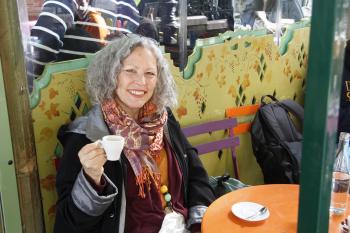Warm memories when you chill in Europe
This item appears on page 53 of the January 2017 issue.
Every summer, Europe greets a stampede of sightseers. Instead of jumping into the peak-season pig pile, consider planning a trip for the off-season, generally November through March. Here are some things to know when planning a winter trip.
IT’S CHEAPER — Off-season airfares are often hundreds of dollars cheaper.
With fewer crowds in Europe, you may find you can sleep for less. Many fine hotels drop their prices, and budget hotels have plenty of vacancies. Also, while many bed-and-breakfasts and other budget accommodations may be closed, those still open are almost empty and, therefore, more comfortable.
The opposite can be true of big-city business centers (especially in Berlin and the Scandinavian capitals), which are busiest with corporate travelers and most expensive off-season.
If traveling without hotel reservations, consider showing up late in the day and letting them know you’re a hosteler (student, senior, artist or whatever) with a particular price limit, then bargain from there.
YOU’LL ENCOUNTER FEWER CROWDS — Off-season adventurers loiter all alone through Leonardo da Vinci’s last home in France, ponder in Rome’s Forum undisturbed, kick up sand on lonely Adriatic beaches and chat with laid-back guards by log fires in a Loire château.
In wintertime Venice, you can be all alone atop St. Mark’s bell tower, watching the clouds of your breath roll over the Byzantine domes of the church to a horizon of cut-glass Alps. Below, on St. Mark’s Square, pigeons fidget and wonder, “Where are the tourists?”
Off-season adventurers enjoy step-right-up service at shops and tourist offices and experience a more European Europe.
Some places are just better off-season. Although many popular tourist-oriented parks, shows and tours will be closed, off-season is in-season for high culture. In Vienna, for example, the Boys’ Choir, opera and Lipizzaner stallions are in all their crowd-pleasing glory.
London’s theater season is in high gear; music lovers can enjoy winter concerts at the grand, red-velvet-draped Royal Albert Hall.
In parts of the Mediterranean, it’s so darn hot in the summer that if you can just bundle up and go off-season, you’ll have a much more comfortable time.
PREPARE FOR THE WEATHER — Make sure to consider weather conditions when you make travel plans. The weather can be miserable — cold, windy and drizzly — and then turn worse.
Europe and North America share the same latitudes and a similar climate, but you can’t go by latitude alone. Madrid and New York City should have similar weather, but Madrid is also 2,000 feet above sea level. Inland areas have colder winters, so Prague can get as chilly as Minneapolis.
Just don’t write off a cold destination just because it’s winter. I spoke to a traveler who swapped the sunny Caribbean for a too-good-to-pass-up deal to Iceland in the dead of winter — with just four hours of daylight — and the breathtaking northern lights viewed from her glacier hike made her glad she did. As long as you dress appropriately, you can have a fine time.
Remember the smart traveler’s mantra: There’s no bad weather, just inappropriate clothing. Pack for the cold and wet — layers of clothing, rainproof parka, gloves, wool hat, long johns, waterproof shoes and an umbrella.
Bundle up. Europe’s wonderful city walking tours go regardless of the temperature. Cold weather is colder when you’re outdoors trying to enjoy yourself all day long, and cheap hotels are not always adequately heated in the off-season.
But, just as summer can be wet and gray, winter can be crisp and blue, and even into mid-November, hillsides blaze with colorful leaves.
BEWARE OF SHORTER HOURS — Because much of Europe is at high latitudes, the winter days are short. It’s dark by 5 p.m. Make a point of getting your day started early so you have a full stretch of daylight to have your fun. Some sights close down entirely, and most operate on shorter hours, with darkness often determining the closing time.
Winter sightseeing is fine in big cities, which bustle year-round, but it’s more frustrating in small tourist towns, which can be boringly quiet, with many sights and restaurants closed down. In December, many beach resorts shut up as tight as canned hams. While Europe’s wonderful outdoor evening ambiance survives all year in the south, wintertime streets are empty in the north after dark.
English-language tours, common in the summer, are rare off-season, when most visitors are natives. Tourist information offices normally stay open year-round but have shorter hours in the winter. Opening times are less predictable, so call ahead to double-check hours and confirm your plans.
With a well-planned itinerary and preparation for weather conditions, a winter trip to Europe can be easier and more relaxed than one during the hectic summer school break. In fact, some of my warmest European memories have been in the chilly off-season.
Rick Steves writes European travel guidebooks and hosts travel shows on public television and public radio. Reach him at Rick Steves’ Europe, Inc., 130 Fourth Ave. N., Edmonds, WA 98020-3114; phone 425/771-8303, www.ricksteves.com.


